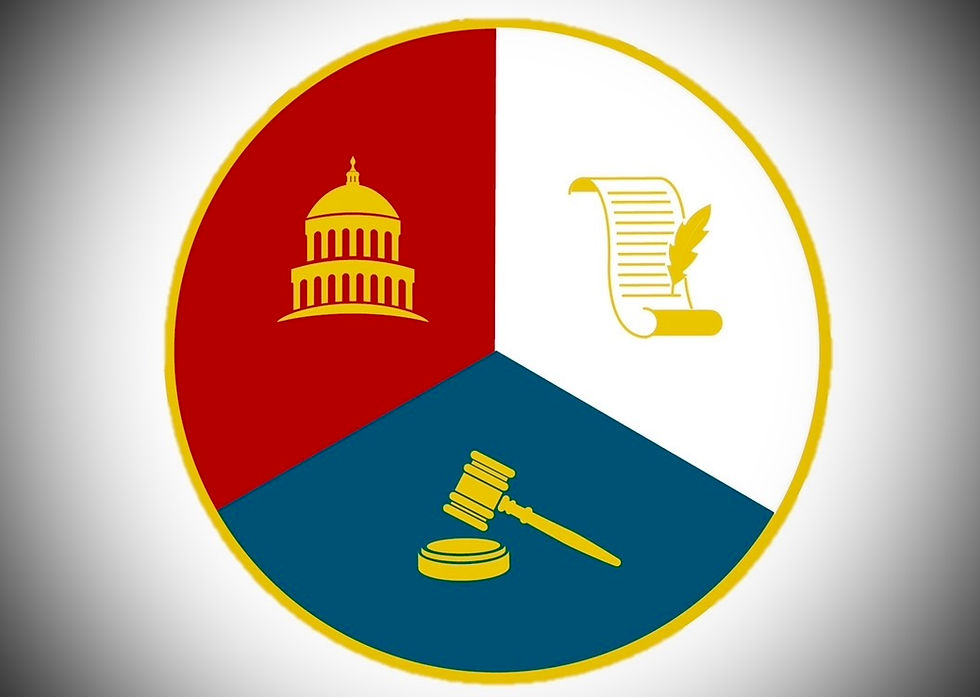Commander-In-Check: How The United States Limits Presidential Power
- Francesca Howard
- Jul 22
- 4 min read
Updated: Aug 2

A visualization of the three branches of government in the U.S.
The President is widely regarded as the most important person in the United States government. After all, they are the symbolic figurehead of the country and, as a result, have many responsibilities. As head of the executive branch, they are tasked with enforcing laws. They set the agenda for how the country will be run and can sign various executive orders, such as we have seen with Donald Trump recently. The President is also the Commander-in-Chief, meaning they are at the very top of the military hierarchy. They possess several diplomatic powers, including the ability to recognize foreign governments, grant amnesty to groups, and pardon any individual convicted of a federal crime. The President has the power to appoint other officials as well, including members of their cabinet and even Supreme Court justices.
However, the President’s power is not absolute. Firstly, there are specific requirements one must meet even to assume office in the first place. The President must be at least 35 years of age, a natural-born citizen of the United States, and should have resided in the United States for a minimum of 14 years. While these requirements may not seem extensive or stringent enough for the highest office in the land, they are essential preliminary requirements that ensure a president’s competency, maturity, integrity, and loyalty to the country. The framers of the Constitution were wary of vesting total control in a single authority. As such, they ensured a system of separation of powers and checks and balances that would limit the President's power over the country. They carefully devised a system wherein the President would have enough power to effectively govern while simultaneously ensuring that they don’t assume so much power that they become authoritarian.
The first mechanism that ensured this is called federalism. This is the systematic separation of powers between the federal and state governments. Federalism delegates specific powers for the federal government to exercise while granting states a certain degree of autonomy. This aligned with the framers’ vision of the United States as both a singular, powerful entity and a union of autonomous states. States, for instance, can regulate matters of morality such as abortion. They also institute their own tax codes in addition to federal taxation. Someone in New York won’t pay the same amount of taxes as someone in Tennessee will. Another notable example is the impact of health restrictions and drug laws. While marijuana usage and distribution are legal in New York, that doesn’t apply to every state. The federal government has limited authority on these issues, so the President does not have much power to influence these decisions.
Next, the framers designed the government so that even within the federal domain, three branches would coexist as equals: the executive, legislative, and judicial branches. They would operate independently of one another, allowing them to check each other should they overstep their power. This is a crucial protective mechanism that limits the President’s authority. For instance, the Supreme Court, part of the judicial branch, has the power of judicial review and can declare laws unconstitutional. Meanwhile, the Senate, part of the legislative branch, has the power to advise and consent, which allows it to approve or reject presidential appointments and decide whether to ratify treaties made with foreign nations. Congress, which includes both the Senate and the House of Representatives, can overturn a president’s veto and even impeach the President if they commit an offense that compromises their character or ability to govern effectively. While no president has ever been removed from office through impeachment, these mechanisms are integral to our governmental system and keeping the President in check.
Perhaps the most important safeguard against a president’s abuse of power is public opinion. While we don’t operate under a direct democracy, our democratic institutions enable us to hold the President accountable. Presidents strive for high approval ratings, especially when considering a re-election bid. Public opinion isn’t as set in stone as the advice and consent powers are, but it is just as, if not more, potent. Unlike a totalitarian or monarchical government, which might suppress dissent, values of free speech undergird the American system to ensure that the government remains accountable to the people. The state exists to serve the interests and protect the rights of the citizenry. If the President fails to do so, they risk losing their power.
All in all, the President’s office is at the very heart of what makes the United States so poweful. It is not an easy job, and thus, there must be precise requirements and regulations that outline exactly what the President's role is in ensuring the safety, security, prosperity, and future of those they represent. While they are granted a high degree of authority and prestige, the President’s power is not absolute. The Constitution and subsequent amendments have established clear duties for the President to carry out, and they ensure that systems are in place to address any instances where the President oversteps their authority. These safeguards are paramount to national security interests, prosperity, and most importantly, the livelihood of the U.S. democracy. Most of all, they protect the citizens against the evils of tyranny and corruption. In keeping with democratic values, the President, as both a representative and trustee of the people, must be held responsible for their actions.


